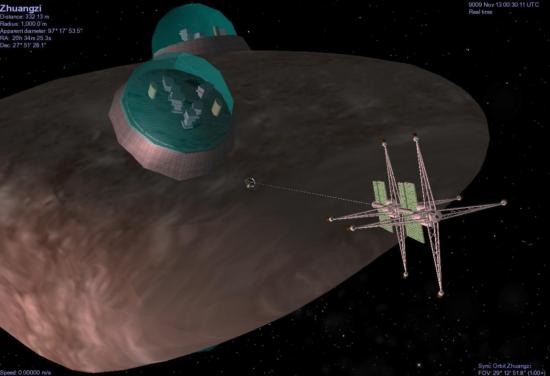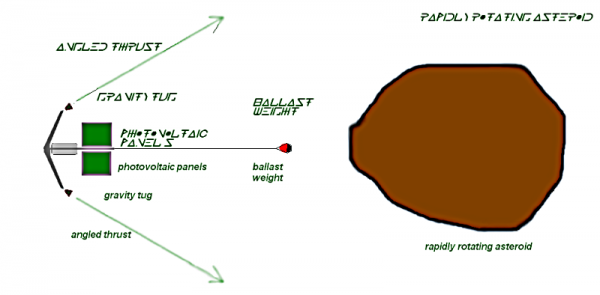BY LETTER
Gravity Tug
Technology > Application > Transportation > Interplanetary Transport
Technology > Application > Transportation > Ships
Technology > Application > Transportation > Ships
AKA Gravity Tractors | |
 Image from Steve Bowers | |
| Sometimes it is necessary to move the asteroids in Barnard's Belt. Here a pair of gravity tugs arranged in tandem are gently pulling this colonised rock to a new orbit | |
Most smaller asteroids rotate quite rapidly, and often tumble about more than one axis. Asteroids smaller than 100 metres in diameter often rotate so fast that centrifugal force could fling any craft or astronaut from the surface of the object. Somewhat larger asteroids rotate less rapidly, but are often loose piles of rubble and aggregate. This makes moving such asteroids in a controlled fashion quite difficult.
The Gravity Tug concept uses the mass of the craft itself to haul the asteroid in the required direction, using gravity and thrust from the craft. The rockets of the gravity tug must be angled so that the exhaust does not hit the surface of the asteroid, otherwise net thrust would be zero. In order to increase efficiency, the tug generally uses a ballast weight consisting of raw asteroid material at the end of a long tether; this moves the centre of gravity of the ship closer to the asteroid, increasing the mutual gravitic attraction.
Gentle thrust from the tug's angled motors (often solarelectric ion rockets in lower tech polities) keep the tug from falling onto the asteroid. This thrust is also transmitted to the asteroid itself by the pull of gravity. Over time small and medium sized asteroids can be moved by this method.
 Image from Steve Bowers |
High-tech versions of the gravity tug exist, using space-time engineering methods only available to higher transapients and above; but they too rely on the pull of gravity to gently move asteroids and similar objects.
Related Articles
Appears in Topics
Development Notes
Text by Steve Bowers
Initially published on 23 May 2008.
Initially published on 23 May 2008.
Additional Information






